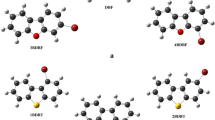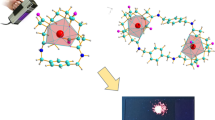Abstract
A DFT/TDDFT (density functional theory/time-dependent density functional theory) investigation on the geometries in the ground and lowest triplet excited states, the frontier molecular orbitals, the absorption spectra and the phosphorescent emission properties of five heteroleptic iridium(III) complexes have been performed to obtain a better understanding of structure–property relationships. The key aim was to investigate the effect of π-conjugation on the photophysical properties of these studied complexes. The lowest energy absorption wavelengths are located at 461 nm for 1, 418 nm for 2, 422 nm for 3, 426 nm for 4 and 417 nm for 5. The lowest energy emissions of complexes 1–5 are localized at 572, 463, 583, 707 and 553 nm, respectively, simulated in acetonitrile medium at M052X level. These findings could be useful to provide good guidance for the further design of new potential phosphorescent organic light-emitting diode (OLED) materials.
Similar content being viewed by others
References
U. Mitschle and P. J. Bäuerle, The electroluminescence of organic materials, J. Mater. Chem., 2000, 10, 1471.
I. Avilov, P. Minoofar, J. Cornil and L. DeCola, Influence of substituents on the energy and nature of the lowest excited states of heteroleptic phosphorescent Ir(III) complexes: A joint theoretical and experimental study, J. Am. Chem. Soc., 2007, 129, 8247.
K. W. Wang, L. M. Yang, X. Wang, L. P. Guo, G. Cheng, C. Zhang, S. B. Jin, B. Tan and A. Cooper, Covalent Triazine Frameworks via a Low-Temperature Polycondensation Approach, Angew. Chem., Int. Ed., 2017, 56, 14149.
L. M. Yang, I. A. Popov, T. Frauenheim, A. I. Boldyrev, T. Heine, V. Baciac and E. Ganz, Revealing unusual chemical bonding in planar hyper-coordinate Ni2Ge and quasiplanar Ni2Si two-dimensional crystals, Phys. Chem. Chem. Phys., 2015, 17, 26043.
X. S. Zeng, M. Tavasli, I. F. Perepichka, A. S. Batsanov, M. R. Bryce, C. J. Chiang, C. Rothe and A. P. Monkman, Cationic bis-cyclometallated iridium(III) phenanthroline complexes with pendant fluorenyl substituents: Synthesis, redox, photophysical properties and light-emitting cells, Chem. – Eur. J., 2008, 14, 933.
C. Ulbricht, B. Beyer, C. Friebe, A. Winter and U. S. Schubert, Recent Developments in the Application of Phosphorescent Iridium(III) Complex Systems, Adv. Mater., 2009, 21, 4418.
Y. You and S. Y. Park, Phosphorescent iridium(III) complexes: toward high phosphorescence quantum efficiency through ligand control, Dalton Trans., 2009, 1267.
X. Li, Q. Zhang, Y. Q. Tu, H. Agren and H. Tian, Modulation of iridium(III) phosphorescence via photochromic ligands: a density functional theory study, Phys. Chem. Chem. Phys., 2010, 12, 13730.
Z. Q. Chen, Z. Q. Bian and C. H. Huang, Functional Ir-III Complexes and Their Applications, Adv. Mater., 2010, 22, 1534.
Q. Zhao, S. J. Liu and W. Huang, Promising Optoelectronic Materials: Polymers Containing Phosphorescent Iridium(III) Complexes, Macromol. Rapid Commun., 2010, 31, 794.
H. F. Shi, Y. Nakai, S. J. Liu, Q. Zhao, Z. F. An, T. Tsuboi and W. Huang, Improved Energy Transfer through the Formation of the beta Phase for Polyfluorenes Containing Phosphorescent Iridium(III) Complexes, J. Phys. Chem. C, 2011, 115, 11749.
J. Qiao, L. Duan, L. Tang, L. He, L. Wang and Y. Qiu, High-efficiency orange to near-infrared emissions from bis-cyclometalated iridium complexes with phenyl-benzoquinoline isomers as ligands, J. Mater. Chem., 2009, 19, 6573.
S. Lamansky, P. Djurovich, D. Murphy, F. Abdel-Razzaq, R. Kwong, I. Tsyba, M. Bortz, B. Mui, R. Bau and M. E. Thompson, Synthesis and characterization of phosphorescent cyclometalated iridium complexes, Inorg. Chem., 2001, 40, 1704.
X. J. Liu, B. Yao, H. L. Wang, B. H. Zhang, X. D. Lin, X. F. Zhao, Y. X. Cheng, Z. Y. Xie and W. Y. Wong, Efficient solution-processed yellow/orange phosphorescent OLEDs based on heteroleptic Ir(III) complexes with 2-(9,9-diethylfluorene-2-yl) pyridine main ligand and various ancillary ligands, Org. Electron., 2018, 54, 197.
L. M. Xie, F. Q. Bai, W. Li, Z. X. Zhang and H. X. Zhang, Theoretical research on the effect of regulated pi-conjugation on the photophysical properties of Ir(III) complexes, Phys. Chem. Chem. Phys., 2015, 17, 10014.
B. Jiang, X. W. Ning, S. L. Gong, N. Jiang, C. Zhong, Z. H. Lu and C. L. Yang, Highly efficient red iridium(III) complexes cyclometalated by 4-phenylthieno[3,2-c] quinoline ligands for phosphorescent OLEDs with external quantum efficiencies over 20%, J. Mater. Chem. C, 2017, 5, 10220.
F. L. Zhang, C. F. Si, X. B. Dong, D. H. Wei, X. Yang, K. P. Guo, B. Wei, Z. Y. Li, C. Zhang, S. Z. Li, B. Zhai and G. X. Cao, Iridium(III) complexes bearing oxadiazol-substituted amide ligands: color tuning and application in highly efficient phosphorescent organic light-emitting diodes, J. Mater. Chem. C, 2017, 5, 9146.
P. Hohenberg and W. Kohn, Inhomogeneous Electron Gas, Phys. Rev., 1964, 136, B864.
C. Adamo and V. Barone, Toward reliable density functional methods without adjustable parameters: The PBE0 model, J. Chem. Phys., 1999, 110, 6158.
P. J. Hay and W. R. Wadt, Ab initio effective core potentials for molecular calculations. Potentials for the transition metal atoms Sc to Hg, J. Chem. Phys., 1985, 82, 270.
P. J. Hay and W. R. Wadt, Ab initio effective core potentials for molecular calculations. Potentials for K to Au including the outermost core orbitals, J. Chem. Phys., 1985, 82, 299.
N. M. O′Boyle, A. L. Tenderholt and K. M. Langner, cclib: A library for package-independent computational chemistry algorithms, J. Comput. Chem., 2008, 29, 839.
M. J. Frisch, G. W. Trucks, H. B. Schlegel, G. E. Scuseria, M. A. Robb, J. R. Cheeseman, G. Scalmani, V. Barone, B. Mennucci, G. A. Petersson, H. Nakatsuji, M. Caricato, X. Li, H. P. Hratchian, A. F. Izmaylov, J. Bloino, G. Zheng, J. L. Sonnenberg, M. Hada, M. Ehara, K. Toyota, R. Fukuda, J. Hasegawa, M. Ishida, T. Nakajima, Y. Honda, O. Kitao, H. Nakai, T. Vreven, J. A. Montgomery, J. E. Peralta, F. Ogliaro, M. Bearpark, J. J. Heyd, E. Brothers, K. N. Kudin, V. N. Staroverov, R. Kobayashi, J. Normand, K. Raghavachari, A. Rendell, J. C. Burant, S. S. Iyengar, J. Tomasi, M. Cossi, N. Rega, N. J. Millam, M. Klene, J. E. Knox, J. B. Cross, V. Bakken, C. Adamo, J. Jaramillo, R. Gomperts, R. E. Stratmann, O. Yazyev, A. J. Austin, R. Cammi, C. Pomelli, J. W. Ochterski, R. L. Martin, K. Morokuma, V. G. Zakrzewski, G. A. Voth, P. Salvador, J. J. Dannenberg, S. Dapprich, A. D. Daniels, O. Farkas, J. B. Foresman, J. V. Ortiz, J. Cioslowski and D. J. Fox, Gaussian 09, Revision A.02, Gaussian Inc., Wallingford, CT, 2009.
T. A. Niehaus, T. Hofbeck and H. Yersin, Charge-transfer excited states in phosphorescent organo-transition metal compounds: a difficult case for time dependent density functional theory?, RSC Adv., 2015, 5, 63318.
C. Cramer and D. Truhlar, Solvent Effects and Chemical Reactivity, Kluwer, Dordrecht, The Netherlands, 1996.
J. P. Perdew, Density-functional approximation for the correlation energy of the inhomogeneous electron gas, Phys. Rev. B: Condens. Matter Mater. Phys., 1986, 33, 8822.
Y. Zhao, N. E. Schultz and D. G. Truhlar, Design of density functionals by combining the method of constraint satisfaction with parametrization for thermochemistry, thermochemical kinetics, and noncovalent interactions, J. Chem. Theory Comput., 2006, 2, 364.
Y. Zhao and D. G. Truhlar, The M06 suite of density functionals for main group thermochemistry, thermochemical kinetics, noncovalent interactions, excited states, and transition elements: two new functionals and systematic testing of four M06-class functionals and 12 other functionals, Theor. Chem. Acc., 2008, 120, 215.
J. P. Perdew, K. Burke and M. Ernzerhof, Generalized Gradient Approximation Made Simple, Phys. Rev. Lett., 1996, 77, 3865.
M. J. G. Peach and D. J. Tozer, Overcoming Low Orbital Overlap and Triplet Instability Problems in TDDFT, J. Phys. Chem. A, 2012, 116, 9783.
Author information
Authors and Affiliations
Corresponding author
Additional information
Electronic supplementary information (ESI) available. See DOI: 10.1039/c8pp00511g
Rights and permissions
About this article
Cite this article
Shang, X., Han, D., Zhao, L. et al. Theoretical insight into the photophysical properties of five phosphorescent heteroleptic iridium(III) complexes bearing oxadiazolsubstituted amide ligands. Photochem Photobiol Sci 18, 1075–1080 (2019). https://doi.org/10.1039/c8pp00511g
Received:
Accepted:
Published:
Issue Date:
DOI: https://doi.org/10.1039/c8pp00511g




